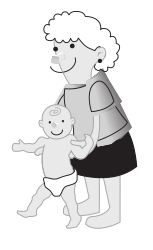The next few articles will be focusing on language delays in children from ages 6 months to 3 years of age. In this first segment in the series, the young baby ages 6-12 months is addressed.
Increasing Language in a Young Baby

Before delving into figuring out how to help a young baby with a language delay, its first necessary to understand how language develops in a baby.
Babies learn language incidentally through imitation and positive reinforcement:
- Imitation: Babies vocally imitate sounds such as “ma” or “da.”
- Positive reinforcement: Babies quickly learn what sounds get a reaction out of people, get them picked up, etc.
At 4-6 months of age, most babies begin to to babble, by combining consonants and vowels such as “mama,” “baba”. Sounds such as “mama” and “dada” won’t have meaning, as being related to parents, until around 12 months. At about six months, babies will respond to hearing their name by turning their head and establishing eye contact . Between 7-12 months, the babbling sounds like it is making sense and babies begin trying tones and patterns similar to parents.
What if your baby isn’t achieving these language developments? You will want to look for the following signs that a young baby has a language delay at 6-12 months:
- Isn’t making or attempting to make any sounds
- Doesn’t make eye contact with you
- Doesn’t make vowel sounds
- Doesn’t respond to name
- Doesn’t respond to sounds around her
- Doesn’t babble at nine months
- Doesn’t say single words “mama” “dada” around 12 months
There are a number of ways a parent can teach language skills to a young baby who isn’t making or attempting to make any sounds, doesn’t make vowel sounds, and/or doesn’t say single words by 12 months:

A) We discussed how sounds develop through imitation. We can teach vocal imitation with an immediate positive reinforcer:
-Example: Food or a favorite toy are great ways to teach-
- Start with a single phoneme
- If baby wants bottle, model “/b/” repeatedly while holding up bottle in front of baby. If baby says “/b/” give bottle immediately.
- Progress from single phoneme to consonant-vowel, to consonant-vowel-consonant, to word, to phrase
B) If the child is having difficulty with vocal imitation, take a step back and teach some non-verbal imitation. Non-verbal imitation can be prompted, vocal imitation cannot. Examples: Clap, tap legs.
- Have a favorite toy (preferably with music and lights) to play immediately as a re-inforcer when the child imitates the action.
- Prompt if child does not imitate.
- This will teach the baby that he/she is supposed to do

C) If the child does not independently make eye contact with you:
- Hold a highly preferred item (favorite toy, pacifier, bottle) in between your eyes.
- This will teach your baby to look at your eyes to get what he/she wants.
- When baby establishes eye contact, give preferred item immediately.
- Practice this many many times.
 D) If your child does not turn head and establish eye contact with speaker after hearing name:
D) If your child does not turn head and establish eye contact with speaker after hearing name:
- Teach this skill by holding a highly preferred toy, food, bottle, etc. in front of you in between your eyes.
- Sit directly in front of the baby.
- While holding the object between your eyes, say the baby’s name.
- When the baby looks at you, give the object immediately.
- The baby then learns that when she hears her name, and she looks, she gets something good.
- Then increase the distance you are from the baby and increase locations to eventually be behind her.
 E) For the young baby struggling with responding to sounds (assuming hearing if normal): Continuously verbally label all environmental sounds around the baby and model the action to do whenever possible:
E) For the young baby struggling with responding to sounds (assuming hearing if normal): Continuously verbally label all environmental sounds around the baby and model the action to do whenever possible:
- Phone ringing, then pick up and answer it
- Play sounds and show pictures of sounds for baby to learn what makes each sound
The next segment in this series on language development will focus on the child between the ages of 13-18 months.


